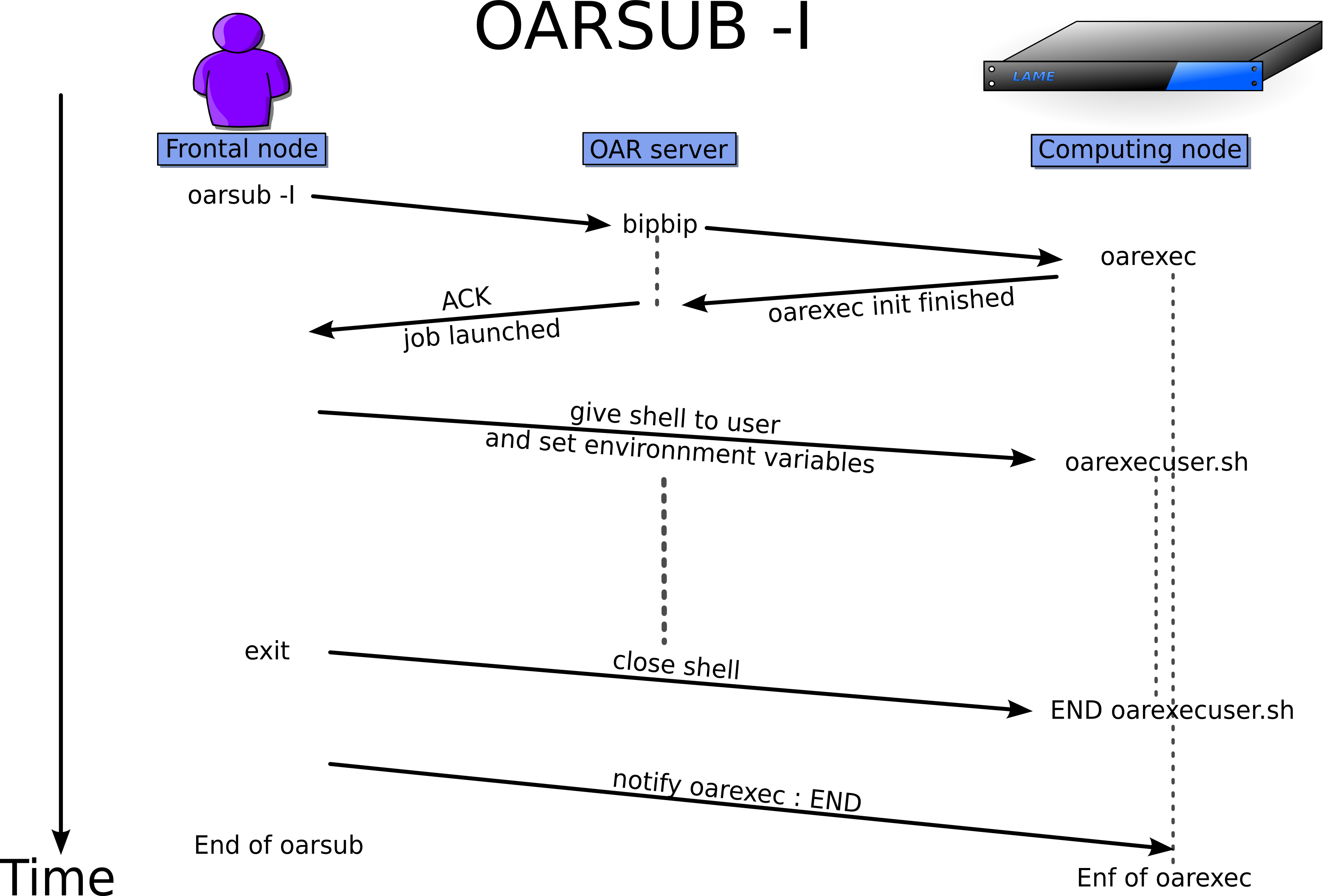Mechanisms¶
How does an interactive oarsub work?¶
Job launch¶
For PASSIVE jobs, the mechanism is similar to the interactive one, except for the shell launched from the frontal node.
The job is finished when the user command ends. Then oarexec return its exit value (what errors occured) on the Almighty via the SERVER_PORT if DETACH_JOB_FROM_SERVER was set to 1 otherwise it returns directly.
CPUSET¶
The cpuset name is effectively created on each nodes and is composed as
user_jobid.
OAR system steps:
- Before each job, the Runner initialize the CPUSET (see CPUSET definition) with OPENSSH_CMD and an efficient launching tool : Taktuk. If it is not installed and configured (TAKTUK_CMD) then OAR uses an internal launching tool less optimized. The processors assigned to this cpuset are taken from the defined database field by JOB_RESOURCE_MANAGER_PROPERTY_DB_FIELD in the table resources.
- After each job, OAR deletes all processes stored in the associated CPUSET. Thus all nodes are clean after a OAR job.
If you don’t want to use this feature, you can, but nothing will warranty that every user processes will be killed after the end of a job.
If you want you can implement your own cpuset management. This is done by editing 3 files (see also CPUSET installation):
- cpuset_manager.pl : this script creates the cpuset on each nodes and also delete it at the end of the job. For more informations, you have to look at this script (there are several comments).
- oarsh : (OARSH) this script is used to replace the standard
sshcommand. It gets the cpuset name where it is running and transfer this information viasshand theSendEnvoption. In this file, you have to change theget_current_cpusetfunction.- oarsh_shell : (OARSH_SHELL) this script is the shell of the oar user on each nodes. It gets environment variables and look at if there is a cpuset name. So if there is one it assigns the current process and its father to this cpusetname. So all further user processes will remind in the cpuset. In this file you just have to change the
add_process_to_cpusetfunction.
SSH connection key definition¶
This function is performed by oarsub with the –ssh_private_key and –ssh_public_key options.
It enables the user to define a ssh key pair to connect on their nodes. So oarsh can be used on nodes of different clusters to connect each others if the same ssh keys are used with each oarsub.
So a grid reservation (-r option of oarsub on each OAR batch
scheduler of each wanted clusters) can be done with this functionality.
Example:
ssh-keygen -f oar_key
oarsub --ssh_private_key ``$(cat oar_key)`` --ssh_public_key ``$(cat oar_key.pub)`` ./script.sh
Suspend/resume¶
Jobs can be suspended with the command oarhold (send a
SIGSTOP on every processes on every nodes) to allow other jobs to be
executed.
Suspended jobs can be resumed with the command oarresume
(send a SIGSTOP on every suspended processes on every nodes). They will
pass into Running when assigned resources will be free.
IMPORTANT: This feature is available only if CPUSET is configured.
You can specify 2 scripts if you have to perform any actions just after (JUST_AFTER_SUSPEND_EXEC_FILE) suspend and just before resume (JUST_BEFORE_RESUME_EXEC_FILE).
Moreover you can perform other actions (than send signals to processes)
if you want: just edit the suspend_resume_manager.pl file.
Job deletion¶
Leon tries to connect to OAR Perl script running on the first job node (find
it thanks to the file /tmp/oar/pid_of_oarexec_for_jobId_id) and sends a
SIGTERM signal. Then the script catch it and normally end the job (kill
processes that it has launched).
If this method didn’t succeed then Leon will flush the OAR database for the
job and nodes will be Suspected by NodeChangeState.
If your job is check pointed and is of the type idempotent
(oarsub -t option) and its exit code is equal to 99 then
another job is automatically created and scheduled with same behaviours.
Checkpoint¶
The checkpoint is just a signal sent to the program specified with the oarsub command.
If the user uses --checkpoint option then Sarko will ask the OAR Perl script
running on the first node to send the signal to the process (SIGUSR2 or the one
specified with --signal).
You can also use oardel command to send the signal.
Scheduling¶
General steps used to schedule a job:
- All previous scheduled jobs are stored in a Gantt data structure.
- All resources that match property constraints of the job(
-poption and indication in the{...}from the-loption of the oarsub) are stored in a tree data structure according to the hierarchy given with the-loption.- Then this tree is given to the Gantt library to find the first hole where the job can be launched.
- The scheduler stores its decision into the database in the gantt_jobs_predictions and gantt_jobs_resources tables.
See User section from the FAQ for more examples and features.
Job dependencies¶
A job dependency is a situation where a job needs the ending of another job to start. OAR deals with job dependency problems by refusing to schedule dependant jobs if their required job is in Terminated state and have an exit code != 0 (an error occured). If the required job is resubmited, its jobId is no longer the same and OAR updates the database and sets the job_id_required field to this new jobId for the dependant job.
| Note: | The queues configured with the quota features (oar_sched_gantt_with_timesharing_and_fairsharing_and_quotas) have a different behaviour. This scheduler always launches dependant jobs even if there required jobs are in Error state or with an exit code != 0. |
|---|
User notification¶
This section explains how the --notify oarsub option is
handled by OAR:
The user wants to receive an email: The syntax is
mail:name@domain.com. Mail section in the Configuration file must be present otherwise the mail cannot be sent. The subject of the mail is of the form:*OAR* [TAG]: job_id (job_name) on OAR_server_hostname
The user wants to launch a script: The syntax is
exec:/path/to/script args. OAR server will connect (using OPENSSH_CMD) on the node where the oarsub command was invoked and then launches the script with the following arguments : job_id, job_name, TAG, comments.
- TAG can be:
- RUNNING : when the job is launched
- END : when the job is finished normally
- ERROR : when the job is finished abnormally
- INFO : used when oardel is called on the job
- SUSPENDED : when the job is suspended
- RESUMING : when the job is resumed
Accounting aggregator¶
In the Configuration file you can set the ACCOUNTING_WINDOW parameter. Thus the command oaraccounting will split the time with this amount and feed the table accounting.
So this is very easily and faster to get usage statistics of the cluster. We
can see that like a data warehousing information extraction method.
Dynamic nodes coupling features¶
We are working with the Icatis company on clusters composed by Intranet computers. These nodes can be switch in computing mode only at specific times. So we have implemented a functionality that can request to power on some hardware if they can be in the cluster.
We are using the field available_upto from the table resources to know when a node will be inaccessible in the cluster mode (easily settable with oarnodesetting command). So when the OAR scheduler wants some potential available computers to launch the jobs then it executes the command SCHEDULER_NODE_MANAGER_WAKE_UP_CMD.
Moreover if a node didn’t execute a job for SCHEDULER_NODE_MANAGER_IDLE_TIME seconds and no job is scheduled on it before SCHEDULER_NODE_MANAGER_SLEEP_TIME seconds then OAR will launch the command SCHEDULER_NODE_MANAGER_SLEEP_CMD.
Timesharing¶
It is possible to share the slot time of a job with other ones. To perform this feature you have to specify the type timesharing when you use oarsub.
Container jobs¶
With this functionality it is possible to execute jobs within another one. So it is like a sub-scheduling mechanism.
First a job of the type container must be submitted, for example:
oarsub -I -t container -l nodes=10,walltime=2:10:00
...
OAR_JOB_ID=42
...
Then it is possible to use the inner type to schedule the new jobs within the previously created container job:
oarsub -I -t inner=42 -l nodes=7
oarsub -I -t inner=42 -l nodes=1
oarsub -I -t inner=42 -l nodes=10
Notes:
In the case:
oarsub -I -t inner=42 -l nodes=11This job will never be scheduled because the container job
42reserved only 10 nodes.
-t containeris handled by every kind of jobs (passive, interactive and reservations). But-t inner=...cannot be used with a reservation.
Besteffort jobs¶
Besteffort jobs are scheduled in the besteffort queue. Their particularity is that they are deleted if another not besteffort job wants resources where they are running.
For example you can use this feature to maximize the use of your cluster with multiparametric jobs. This what it is done by the CIGRI project.
When you submit a job you have to use -t besteffort option of
oarsub to specify that this is a besteffort job.
Important : a besteffort job cannot be a reservation.
If your job is of the type besteffort and idempotent
(oarsub -t option) and killed by the OAR scheduler then
another job is automatically created and scheduled with same behaviours.
Cosystem jobs¶
This feature enables to reserve some resources without launching any program on corresponding nodes. Thus nothing is done by OAR on computing nodes when a job is starting except on the COSYSTEM_HOSTNAME defined in the configuration file.
This is useful with an other launching system that will declare its time slot in OAR. So yo can have two different batch scheduler.
When you submit a job you have to use -t cosystem option of
oarsub to specify that this is a cosystem job.
These jobs are stopped by the oardel command or when they reach their walltime or their command has finished. They also use the node COSYSTEM_HOSTNAME to launch the specified program or shell.
Deploy jobs¶
This feature is useful when you want to enable the users to reinstall their reserved nodes. So the OAR jobs will not log on the first computer of the reservation but on the DEPLOY_HOSTNAME.
So prologue and epilogue scripts are executed on DEPLOY_HOSTNAME and if the user wants to launch a script it is also executed on DEPLOY_HOSTNAME.
OAR does nothing on computing nodes because they normally will be rebooted to install a new system image.
This feature is strongly used in the Grid5000 project with Kadeploy tools.
When you submit a job you have to use -t deploy option of
oarsub to specify that this is a deploy job.
Quotas¶
The administrator can limit the number of resources used by user, job types, project ans queue (or a combination of them). This feature acts like quotas. When one of the defined rules is reached then next jobs will not be scheduled at this time. The scheduler will find another slot when the quotas will be satisfied.
This feature is available in queues which use the scheduler
oar_sched_gantt_with_timesharing_and_fairsharing_and_quotas.
The quota rules are defined in /etc/oar/scheduler_quotas.conf.
By default no quota is applied.
Note1: Quotas are applied globally, only the jobs of the type container are
not taken in account (but the inner jobs are used to compute the quotas).
Note2: Besteffort jobs are not taken in account except in the besteffort queue.
Desktop computing¶
If you cannot contact the computers via SSH you can install the desktop
computing OAR mode.
This kind of installation is based on two programs:
- oar-cgi : this is a web CGI used by the nodes to communicate with the OAR server via a HTTP server on the OAR server node.
- oar-agent.pl : This program asks periodically the server web CGI to know what it has to do.
This method replaces the SSH command. Computers which want to register them into OAR just has to be able to contact OAR HTTP server.
In this situation we don’t have a NFS file system to share the same directories
over all nodes so we have to use a stagein/stageout solution. In this case you
can use the oarsub option stagein to migrate your data.

